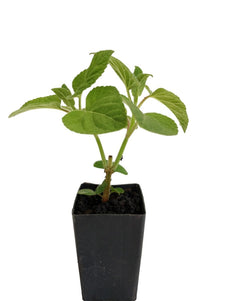
Salvia puberula
Salvia puberula
- Low stock - 3 items left
- Inventory on the way

Usually available: All year
Life cycle: Perennial
Height: 1 - 1.5m
Position: Sun / part shade
Soil preference: Well drained
This is how we pack and send your Herb Plants to all states except TAS & WA
Botanical Name: Salvia puberula
Salvia puberula is a medium growing shrub reaching up to 1- 1.5 meter high by a similar width, although it may not reach this size in Australian gardens. It has lime green, heart shaped leaves that may be up to 10 cm long. The leaves and much of the stem and flowers are be covered in fine hairs. The winter flowers are held on top of a floral spike and are usually pink, although the tone may vary. They extend out at various angles looking much likely a large hairy pink spider.
Salvia puberula has undergone several stages of taxonomic investigation over a long period because of its relationship to Salvia involuctrata. In 1900, this salvia was noted to be closely related to S. involucrata but designated as a separate species. Since then, it has been deemed to be a subspecies and the correct designation is Salvia involucrata subsp puberula. The name ‘puberula’ refers to the ‘pubescence’ or fine hairs covering the plant. This salvia may also be called the Tarantula Salvia in some regions, due to the appearance of the flowers. However, there are several forms in Australia and some people refer to all of them as Rose Leaf Sage in deference to S. involucrata.
Salvia involucrata subsp puberula is native to Mexico, but is rarely seen in the wild. When found it is clear that this plant prefers to grow near trees and other shrubs that offer wind and sun protection. If this pattern can be replicated in the home garden then the plant will benefit greatly. Choose a full sun to part shade position offering protection from heat and hot winds where possible. This salvia likes well drained soil, but appreciates warm and wet, but not damp, environments. A very deep watering once every two weeks is recommended. It is hardy to about -2 Celcius, but does not like cold conditions and will not tolerate frost. The stems of this plant root easily and propagation may be from cuttings.
The salvia family has over 900 members with an extensive history as culinary, medicinal and ornamental plants. Ornamental salvias have become collectors items, as gardeners try to find a place in their garden for each and every one. There are salvias that will suit every type of soil and climate. More information on the Salvia genus and Common Sage (Salvia officinalis) may be found on our Common Sage page.
All information provided on this website is for informational purposes only. Please seek professional advice before commencing any treatment.




